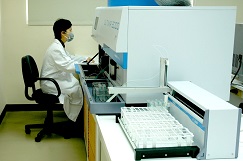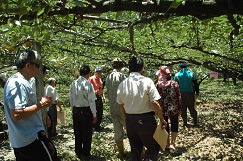|
|
The objectives of soil and fertilizers are to promote the diagnosis of soil nutrition, rational fertilization techniques, and the development of culture medium made from agriculture substrate resource. These endeavors are expected to increase farmers’ fertilizer usage efficiency and promote sustainable soil management. Since 2008, an average of 23 seminars on soil properties and rational fertilization have been held each year, attracting an annual average number of 1,450 participants; the average number of field achievement seminars hosted per year is 17, with 1,110 participants; and the average number of events organized to help advocate government policy is 140. The number of samples analyzed annually is 3,600, which enables the provision of services such as soil management and fertilizer recommendations to 540 people per year. To improve the efficiency of public service, we not only purchased new equipment featuring fast analysis speed, but also adjusted the analysis process by reducing the soil sample analysis time from 1 month to 2 weeks. This decreases the time that farmers must wait each year by more than 50,000 days. The number of people served has grown steadily at 13% per year, and over 2,000 pieces of soil samples have been analyzed. Statistical analysis indicated an upward trend in test data falling within the appropriate range, indicating favorable results concerning the promotion of the rational fertilization concept. Regarding the research and development of rational fertilization techniques, nutrient diagnosis standards of crops such as pomelos, grafted pears, and kumquats were established. In addition,nutrient management techniques for rice, feed corn, and the aforementioned crops were developed to help farmers understand the optimal nutrient supply, soil fertility, and the optimal fertilization period. At least 200 crop and soil samples were collected each year to enrich the soil database. These data can be used by the agricultural environment and geography information system in the future to assess the safety of agricultural products. Concerning the techniques used to develop high-quality soil environments, we established the molecular biology method for investigating the diversity of microorganisms in farmland soil and performed objective analyses to evaluate the effect of organic agriculture on ecological environment. In addition, we introduced a technique for analyzing antioxidant capacity to prove that organic cultivation can increase the nutritional value of agricultural products. Furthermore, we proposed techniques for comprehensively managing the byproducts and cultivation of fertilizers in organic farms growing leafy greens and reduce the amount of fertilizer used by organic vegetable farmers as well as the cost for waste treatment. To develop high-quality cultivation mediums and soil improvement materials, we designed hanging type biochar maker. Each ton of rice hulls can produce 300 kg of carbonized rice hulls and 150 L of byproduct rice hull vinegar solution, increasing revenue by more than NT$70,000. The increased revenue significantly increased the added value of rice hulls and engendered a new green industry. |
|---|



